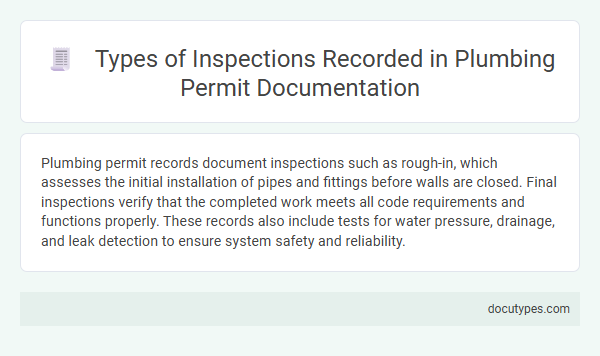Plumbing permit records document inspections such as rough-in, which assesses the initial installation of pipes and fittings before walls are closed. Final inspections verify that the completed work meets all code requirements and functions properly. These records also include tests for water pressure, drainage, and leak detection to ensure system safety and reliability.
Overview of Plumbing Permit Inspections
Plumbing permit inspections record various types of evaluations to ensure compliance with local codes and safety standards. These inspections verify that plumbing systems are installed and functioning correctly throughout different construction stages.
The overview of plumbing permit inspections includes rough-in inspections, where the basic pipe layouts are checked before walls are closed; pressure tests to confirm system integrity and leak-free connections; and final inspections that assess the complete plumbing installation for proper operation. Inspectors also review water heater installations, drainage systems, and venting to ensure they meet regulatory requirements. Accurate records of these inspections provide a documented history of compliance and help prevent future plumbing issues.
Rough-In Plumbing Inspection
| Inspection Type | Description | Purpose | When It Occurs |
|---|---|---|---|
| Rough-In Plumbing Inspection | Assessment of the initial plumbing installation before walls and floors are sealed. | Ensures pipes, drains, vents, and water supply lines are correctly installed and comply with code requirements. | After installation of plumbing lines but before covering with drywall or flooring. |
| Drainage and Vent Inspection | Focuses on the drainage system and venting components. | Verifies proper slope, connections, and venting to prevent sewer gases and ensure drainage efficiency. | Often part of or immediately following the rough-in inspection phase. |
| Water Supply System Inspection | Reviews water distribution piping, valves, and backflow prevention devices. | Confirms the integrity of fresh water supply and adherence to safety standards. | During or after the rough-in inspection stage. |
| Final Plumbing Inspection | Comprehensive review of the entire plumbing system after completion. | Checks fixtures, appliances, and system operation to ensure full code compliance. | After all plumbing work is complete and fixtures are installed. |
Your plumbing permit records primarily document the rough-in plumbing inspection, a crucial step in the permit approval process. This inspection safeguards that all hidden plumbing components meet local codes before finishing work progresses.
Underground Plumbing Inspection
What types of inspections are recorded in plumbing permit records related to underground plumbing inspection? Underground plumbing inspections primarily focus on verifying the installation of pipes and fixtures beneath the ground before they are covered. These inspections ensure compliance with local plumbing codes and prevent future leaks or contamination.
Above Ground Plumbing Inspection
Above ground plumbing inspections are a critical part of plumbing permit records. These inspections ensure that the visible plumbing systems meet safety and code requirements before being covered or concealed.
- Verification of Pipe Installation - Inspectors check the correct placement and secure fitting of pipes above ground.
- Assessment of Venting Systems - Proper venting is reviewed to prevent sewer gas leaks and maintain system pressure.
- Evaluation of Fixture Connections - All connections to sinks, toilets, and other fixtures are inspected for leaks and compliance.
Your permit records document these inspections to confirm that the above ground plumbing follows regulatory standards throughout the project.
Final Plumbing Inspection
Plumbing permit records document various inspections conducted throughout the project, with the final plumbing inspection being a critical component. This final check validates that all plumbing work meets local codes and safety standards before the system is approved for use.
During the final plumbing inspection, inspectors verify the installation of pipes, fixtures, and connections for compliance and functionality. Your plumbing permit records will include detailed results from this inspection, confirming the project's completion and adherence to regulations.
Water Supply Line Inspection
Water supply line inspections are a critical component recorded in plumbing permit records to ensure compliance with local building codes. Inspectors verify the proper installation, pressure, and material quality of supply lines to prevent leaks and contamination. Detailed documentation of these inspections helps maintain safe and reliable water distribution within residential and commercial properties.
Drain, Waste, and Vent (DWV) Inspection
Plumbing permit records commonly include Drain, Waste, and Vent (DWV) inspections to ensure proper installation and functionality. DWV inspections verify that pipes for wastewater and ventilation systems comply with local building codes, preventing leaks and blockages. Inspectors assess the integrity of drains, waste lines, and venting to maintain safe and efficient plumbing systems.
Gas Piping System Inspection
Gas piping system inspections are a critical component documented within plumbing permit records to ensure safety and compliance. These inspections verify the proper installation, integrity, and functionality of gas piping systems in residential and commercial properties.
- Initial Installation Inspection - Confirms that the gas piping is installed according to code requirements before being covered or concealed.
- Pressure Testing - Ensures the gas pipes maintain required pressure levels without leaks throughout the system.
- Final Inspection - Verifies that all components are properly connected, operational, and safe for use before the permit is closed.
Backflow Prevention Device Inspection
Plumbing permit records include various inspection types to ensure system compliance and safety. One critical inspection type documented is the Backflow Prevention Device Inspection.
Backflow prevention devices are examined to verify they effectively prevent contaminated water from flowing back into the potable water supply. Inspectors check device installation, operation, and maintenance as part of the inspection process.
What Types of Inspections Are Recorded in Plumbing Permit Records? Infographic

